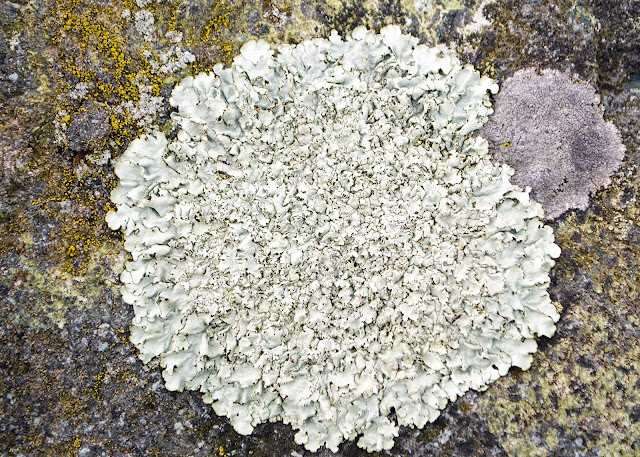Some lichens are picky in their choice of growing sites. Reading through the habitat section in the guide book, I find such narrow ranges for specific lichens as, "near waterfalls" or "on sloping rock", "among the roots of fallen trees in shady sites at lower elevations", "on smooth bark of deciduous trees"; "acid mineral soil", and so on. Some will grow only on conifers, some prefer alders. Some like their wood alive, some want old lumber. Some prefer their rock to be freshly exposed; others are happy with any rock, as long as it's in the right location.
So looking at lichen, trying to identify each type, it helps to notice where exactly it was growing, not only the substrate, but its surroundings.
These four grow in the Oyster Bay Shoreline Park, all on the edges of the small meadow.
 |
| Cladonia spp. |
This was growing on the cut end of a very old fence rail. A few grew on other cut areas, but not along the length of the rail.
 |
| Could be Bull's eye lichen. |
I couldn't get down close to this rock for a better look. The lichen grew on two large rocks a few metres apart, in an exposed spot with little to no shade. Going by the age of rocks and of lichen, this could classify as "freshly exposed"; the park was only developed 30 years ago, and these rocks bolster the new dike.
 |
| Brand-new lungwort. |
Two patches of this lichen are growing in the shade on an old cottonwood. More grows on other cottonwoods nearby. Lungwort likes trees in humid forests, and this is a dry site, but cottonwood is a water-loving tree with an extensive root system, and its wood is always wet.
 |
| A dust lichen |
This dust grows on the same cottonwood, near the roots on the more exposed side where it receives a bit of sunlight but is protected from rain by dense branching overhead.
Note: paying attention to the growing site won't identify the lichen, but it helps. It helps.
~~~~~~~~~~~~~~~~~~~~~
Algunos de los líquenes tienen ideas muy concretas acerca de donde quieren vivir. Leyendo en mi libro guía, en las descripciones del habitat de cada liiquen, encuentro descripciones tan específicas como, por ejemplo: "cerca de cataratas", o "sobre piedra inclinada", entre las raices de árboles caídos en lugares con sombra en alturas bajas", "en la corteza lisa de árboles de hoja caduca", "en tierra mineral ácida", y así por el estilo. Algunos crecen solamente en los coníferos; otros prefieren alisos. Algunos necesitan madera viva; otros la quieren muerta y bien podrida. Hay los que buscan rocas recién expuestas al aire; otros aceptan cualquier roca con tal de que esté en su lugar preferido.
Así es que, al tratar de identificar un liquen, hay que considerar el sitio, no solo del sustrato, sino del ambiente donde se halla.
Estos cuatro crecen en el parque Oyster Bay Shoreline, en los bordes del pequeño prado.
Foto #1: Cladonia spp. creciendo en el extremo cortado, muy viejo, de un riel del cerca. Donde otros rieles llevaban cortes, también crecía este liquen, pero no a lo largo de los mismos rieles.
Foto #2: Puede ser el liquen Placopsis gelida. No pude bajar para verlo mejor. Crece en dos rocas grandes separados por unos cuantos metros en un sitio expuesto a los elementos, sin protección de árboles. Tomando en cuenta las edades de rocas y de sus líquenes, esta roca puede tal vez considerarse como "recién expuesta", ya que el parque mismo tiene apenas 30 años, y las rocas que aquí sostienen el dique nuevo habrán sido colocadas después de esto.
Foto #3: Una Lobaria pulmonaria nuevecita. Crece en la sombra en la corteza de un álamo viejo. Más ejemplares crecen en otros álamos alrededor. A este liquen le gustan los sitios húmedos, y este lugar es más bien seco, pero el álamo es un árbol amante del agua con un sistema de raices muy extendido, y la madera siempre está mojada.
Foto #4: En el otro lado del mismo álamo, cerca de las raices, donde le llega un poco de sol, pero donde las ramas entrelazadas arriba le protegen de la lluvia, crece este liquen polvoriento.
Hay que recordar que aun al establecer el sitio, eso no asegura la identificación. Pero ayuda.




























